Right Back at It Again Piano Tutorial
Have you lot ever seen those messages up above the staff in your canvass music and wondered what they are? Those letters are chord symbols. Although guitar players use chord symbols all the time, for many beginning pianoforte students chords are a mysterious art. Simply for folk, jazz, pop, and rock musicians, chords are the foundation of how they remember about, play, and perform music. In this article I'll tell you how to make piano chords, how to read chord symbols, and lots of means to use chords to make your piano playing more amazing than ever.
Part 1 – What Is a Chord?
Almost simply put, if you play more than one note at a time you've got a chord. And then which notes practice you lot play to make what chord? With eighty-eight keys on the piano, that makes an impossible number of combinations, correct? Really information technology's simpler than that. The piano keyboard is made upwardly of just twelve tones. These tones, called the chromatic scale, repeat as you become up the keyboard. Each white or black primal is included in the scale, and is a half step away from the keys next to it. Every bit y'all go upward the keyboard, twelve half steps will bring you lot right dorsum to where you started in the sequence of tones. When you lot make a chord, the distance, measured in half steps, between the tones of a chord determines what kind of chord it is.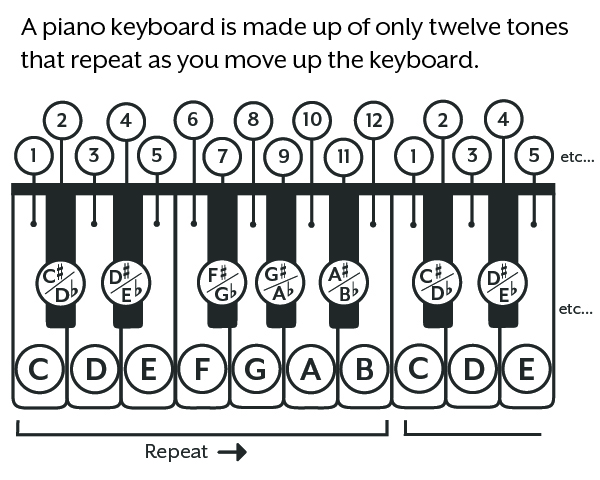 Most chords in modern-day Western music are either a major chord or a pocket-sized chord. 90-9 percent of all popular music, and almost as much classical music, is built on these 2 kinds of chords and their variations.
Most chords in modern-day Western music are either a major chord or a pocket-sized chord. 90-9 percent of all popular music, and almost as much classical music, is built on these 2 kinds of chords and their variations.
Major Chords
Major and minor chords are made up of three tones, chosen the root, the third, and the 5th. Chords are always named for their root. The C major chord, for case, will have a C every bit its root and lowest note. The third is going to be the third tone of the C major scale, or an E. The fifth will be the fifth tone of the C major scale, or the 1000. A major chord sounds similar a major chord no matter what annotation information technology has for its root. This is because the number of half steps between each of the notes will always be the same. Between the root and the tertiary you will always accept iv half steps, an interval known equally a major 3rd. The top two notes of the chord, from the third to the fifth, will exist three half steps apart, or a pocket-sized 3rd. This is how you build a major chord starting from Whatsoever of the twelve tones of the chromatic scale.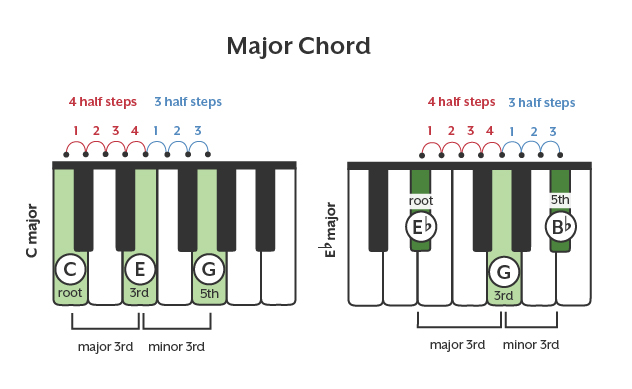 Say yous want to make a D major chord. Count upwardly 4 half steps from D, and you lot become F-sharp. And so count upwardly three more half steps from F-sharp, you get A. The D major chord is D, F-abrupt, A. At present say you lot desire to showtime on a black primal, such as Due east-flat. Brand the chord the same fashion. Count up 4 half steps to G, then three half steps to B-flat. Your E-apartment major chord is E-flat, Yard, B-flat. If you accept your piano keyboard handy, see if you tin can play each major chord, 1 for each of the twelve tones. You tin hear how each major chord has a similar sound. This is because their notes have the same relationship to each other. At present, dorsum to those letters above the musical staff. For a major chord, you'll only see the letter proper noun of the root as a capital letter. For an E major chord, y'all'll encounter a upper-case letter "Eastward" above the staff. "F#" ways play an F-sharp major chord. "A" means play an A major chord. That's all there is to it.
Say yous want to make a D major chord. Count upwardly 4 half steps from D, and you lot become F-sharp. And so count upwardly three more half steps from F-sharp, you get A. The D major chord is D, F-abrupt, A. At present say you lot desire to showtime on a black primal, such as Due east-flat. Brand the chord the same fashion. Count up 4 half steps to G, then three half steps to B-flat. Your E-apartment major chord is E-flat, Yard, B-flat. If you accept your piano keyboard handy, see if you tin can play each major chord, 1 for each of the twelve tones. You tin hear how each major chord has a similar sound. This is because their notes have the same relationship to each other. At present, dorsum to those letters above the musical staff. For a major chord, you'll only see the letter proper noun of the root as a capital letter. For an E major chord, y'all'll encounter a upper-case letter "Eastward" above the staff. "F#" ways play an F-sharp major chord. "A" means play an A major chord. That's all there is to it.
Instance of a Major Chord Symbol (C major chord): C
Minor Chords
A minor chord is built like an upside-down major chord. It puts the minor 3rd on the lesser, from root to third, and major 3rd on top from the third to the fifth. Minor goes on bottom, major goes on top, and the fifth goes in the aforementioned place. To brand a minor chord, get-go on any of the twelve tones of the chromatic scale. To apply C as an instance again, the C modest chord volition accept the same root, the C, only and so going up iii half steps (a minor tertiary) takes united states to an E-flat. Four more one-half steps (a major 3rd) brings us to G. If you want to brand a D minor chord, you'll utilize D, F, and A.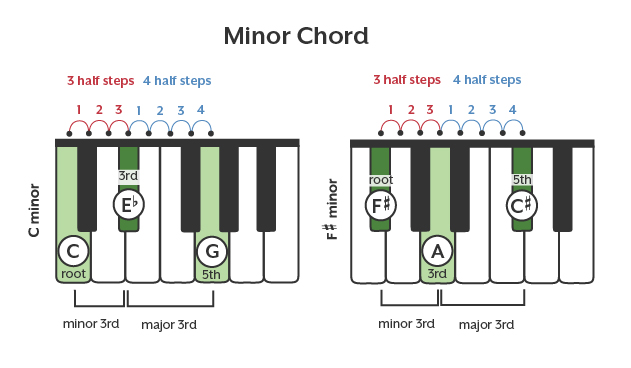 You might have noticed that to change from a major to a minor chord, all you lot have to do is to motility the third (the middle tone) down by one one-half step. This tiny change swaps a major chord for a small-scale chord. So, if you know the major chord, create the minor chord merely past lowering the third a one-half step. Give it a try on your piano. Effort to make every possible minor chord, all twelve of them. In chord symbols, a capital letter letter and so a lower case "m" indicates a minor chord. For example, the A minor chord is written, "Am." Sometimes you run into "min" instead of just "m," merely that is less common. You might besides see a minus sign for small, only that happens fifty-fifty less often.
You might have noticed that to change from a major to a minor chord, all you lot have to do is to motility the third (the middle tone) down by one one-half step. This tiny change swaps a major chord for a small-scale chord. So, if you know the major chord, create the minor chord merely past lowering the third a one-half step. Give it a try on your piano. Effort to make every possible minor chord, all twelve of them. In chord symbols, a capital letter letter and so a lower case "m" indicates a minor chord. For example, the A minor chord is written, "Am." Sometimes you run into "min" instead of just "m," merely that is less common. You might besides see a minus sign for small, only that happens fifty-fifty less often.
Minor Chord Symbols (C minor chord): Cm, C min, C-
Other Chords
In jazz and another styles yous'll probably come beyond the more edgy, dissonant diminished chord, congenital on ii pocket-sized thirds. For instance, to brand a C diminished you employ C, E-flat, and M-flat. Or for D diminished y'all'd demand D, F, and A-apartment. Try a few macerated chords out on your pianoforte to hear for yourself their unique, unsettled sound. There are also the rather bizarre, space-age augmented chords, built on ii major thirds, like C, Due east, G#. Yes, macerated and augmented chords are much less mutual than major and minor chords, but for that moment that you come up beyond them, you'll want to be set up to impress your friends by having them in your repertoire. For a diminished chord you'll see the root followed by the letters "dim." Sometimes you lot'll see a small open circle, like a degree sign. For augmented you lot usually run into "aug" following the alphabetic character proper noun of the root, or a + symbol.
Macerated Chord Symbols (C diminished): C dim, Cº
Augmented Chord Symbols (C augmented): C aug, C+
Sevenths, Suspensions, and More
Add flavor and color to any of these chords past adding one or more than tones to your bones root, 3rd, and fifth. The added tones are ordinarily indicated with a number written after the chord symbol. The number ways to add that tone in the calibration, starting with the root as "1." You might see a 6, 7, ix, 11, or 13. Those numbers e'er correspond to a note measured that far from the root in the regular major or pocket-size (not chromatic) scale. Count the root every bit i, so go by the calibration that begins on the root. One of the most common added tones is a seventh. An easier mode to recall about 7th for now will be that the seventh is an extra minor third on top of the fifth. The C7 chord is spelled C, E, G, B-flat. Sometimes you'll run into a slightly different variation, written C maj 7. That merely means to use a major third instead of a small-scale third on top of the chord, or C, E, G, B.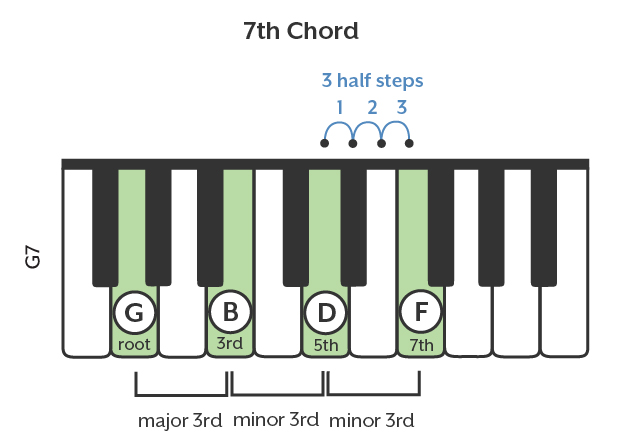 Y'all can also have a intermission chord, which replaces a tone in the chord with some other tone. For instance, if you run across C sus 4, that number 4 means you lot'll play the fourth tone to a higher place the root instead of the 3rd, or C, F, G. F sus 4 would be F, B-apartment, C. An F sus two chord symbol means play the 2nd tone of the scale instead of the 3rd, or F, G, C.
Y'all can also have a intermission chord, which replaces a tone in the chord with some other tone. For instance, if you run across C sus 4, that number 4 means you lot'll play the fourth tone to a higher place the root instead of the 3rd, or C, F, G. F sus 4 would be F, B-apartment, C. An F sus two chord symbol means play the 2nd tone of the scale instead of the 3rd, or F, G, C.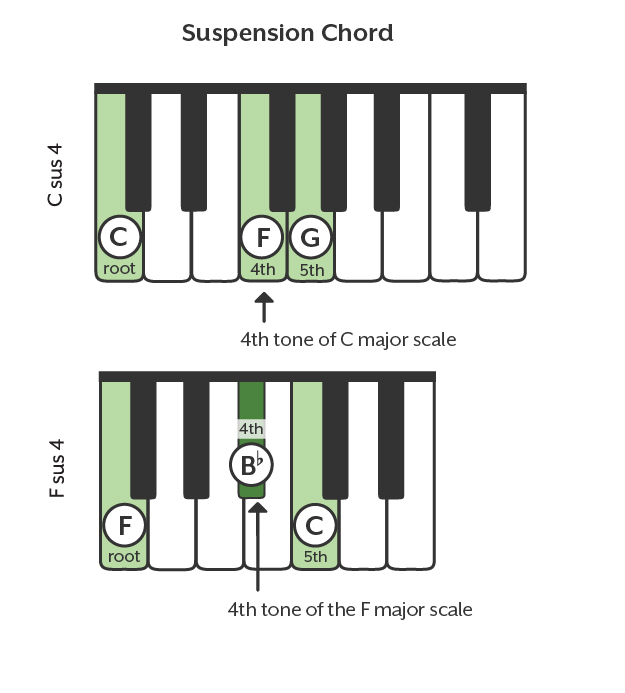 One other common thing you see in chord symbols is two capital letters divided by a slash, such every bit C/G. This doesn't mean you go to choose whether to play a C or a Chiliad chord. It ways to play a C chord with a unmarried G note below in the bass. For pianists, this means you'll use your right hand to play the chord (the letter before the slash), and use your left hand to play the annotation later the slash down low on your piano (simply a single note, not a chord).
One other common thing you see in chord symbols is two capital letters divided by a slash, such every bit C/G. This doesn't mean you go to choose whether to play a C or a Chiliad chord. It ways to play a C chord with a unmarried G note below in the bass. For pianists, this means you'll use your right hand to play the chord (the letter before the slash), and use your left hand to play the annotation later the slash down low on your piano (simply a single note, not a chord).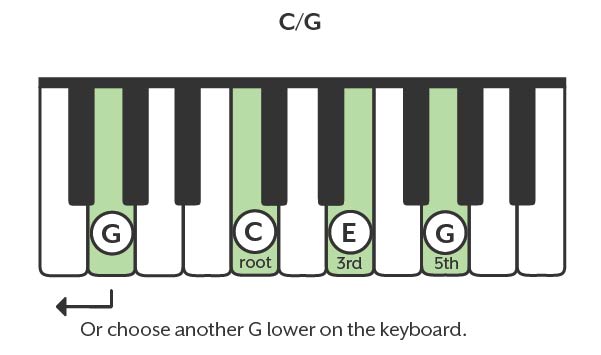
Office ii – Playing with Chords
At present that you know what notes brand upwardly a chord, what next? Chord symbols guide you as you make up your own accompaniment to a vocal by telling you what notes you lot can play, just you lot choose when and where to play them.
Get to Know Your Roots
The simplest way to use chord symbols is to play the melody with your right hand, and every time you meet a chord symbol above the staff, play one single note, the root of the chord, with your left hand. If you see a letter of the alphabet C to a higher place the staff, play a C with your left hand. If y'all see an A♭, play an A-flat. It'south that easy. If that goes well and you lot're feeling set up for a bigger challenge, endeavor playing the root of the chord in a simple rhythm. When y'all meet a chord symbol above the staff, yous tin assume that chord will continue until the chord changes, no thing how many measures become by earlier the next chord symbol. So if there'south a G to a higher place one measure, go along playing Thousand at the first of each measure until you lot run into the adjacent chord symbol. You can also create an exciting pulse of sound by playing the root of the chord once per shell, or even once per every half of a beat! You can mix the rhythm up however yous similar. Call up of the note you're playing with your left mitt like the drum trounce to the vocal.
Blocked Chords
Now that you lot've got the root of the chord down, and can play information technology with your pick of rhythm, try stacking the other notes of the chord on height of information technology. If you're new to the piano and have a hard time playing all three notes of a major or modest chord, you can choose to play either just the root and the 3rd, or merely the root and the fifth. In one case again, you tin can play merely every time y'all see a chord symbol indicating that the chord changes, or you tin can play once a measure, or play in any rhythm you like. Attempt playing one octave below the melody, then two octaves below or more than to see how the sound changes. For a fresh, fun sound, you can even play the chords above the melody! Try out unlike rhythms with blocked chords, just like you did with the root of the chord. Playing the chords with different rhythms can completely modify the experience of a song. Experiment to find out what y'all think sounds best.
Broken Chords and More
Instead of playing all the notes of a chord at the same time, yous can play them ane at a time. If you've played arpeggios on the piano, this is exactly what'southward going on. You're playing a chord 1 note at a time. This tin add a really overnice audio to your accessory design. You tin can play the root first and go up, yous can play the top note of the chord first and go downwardly, or you tin can mix information technology up and make whatever new design you lot like. One famous accompaniment pattern common in classical music, known as the Alberti bass, plays: root, 5th, third, fifth, root, 5th, 3rd, fifth. This pattern continues through the whole song, shifting to a new root with each chord change. The Alberti bass creates a nice classical audio in your accompaniment. A expert march beat can be made by alternating the root and the fifth. To make a waltz accompaniment design, play first the root only on beat i, then the third and 5th together on beats ii and 3 to make a kind of "oom-pah-pah" sound. As you play songs using chord symbols don't be afraid to try different things and notice accompaniment patterns to create a experience that yous like. Once you know the notes in the chord, y'all tin play any of those notes in whatsoever rhythm that sounds right to yous.
Enjoy the Power and Freedom of Chords
At present y'all're set to play using chord symbols! One of my favorite series for children that uses chord symbols is the Wee Sing books, with melody lines and chord symbols for many favorite children's songs. For older learners, yous tin find many collections of sheet music written with simply a melody line and chord symbols. This is called "lead sheet" style. Large collections of lead sheets are often sold together in what'southward chosen a "Fake" book, and then called considering in one case you lot know the chords you can imitation the accompaniment. I'd prefer to say "make your own" accompaniment. There's nothing fake nigh that! Yous can also look for music that says "for Vocal/Guitar," which will e'er include chord symbols. Explore the earth of chords and accept fun making music in a whole new manner.
Happy playing,
Joseph Hoffman
Source: https://www.hoffmanacademy.com/blog/read-chord-symbols-piano/
0 Response to "Right Back at It Again Piano Tutorial"
Enviar um comentário